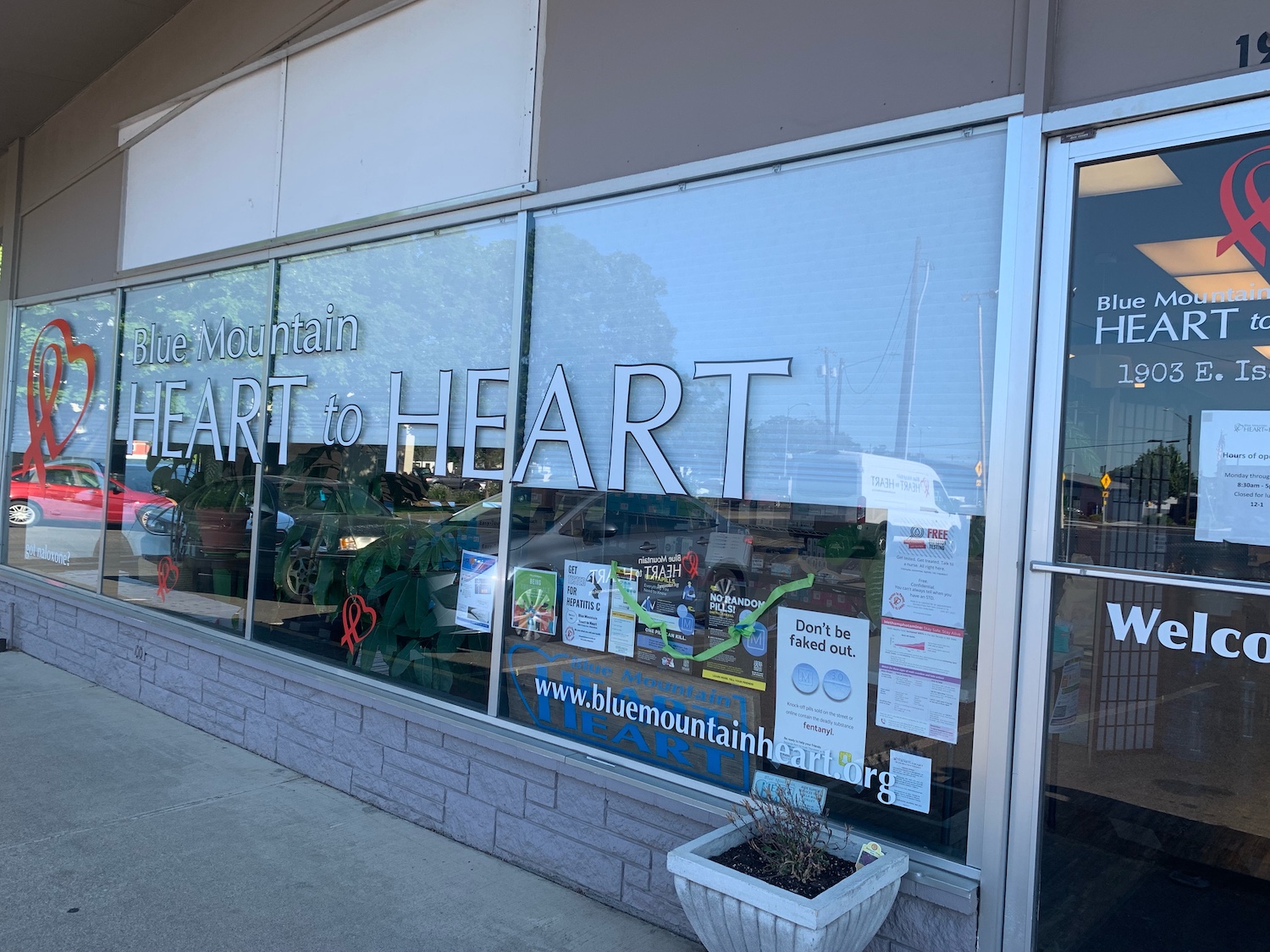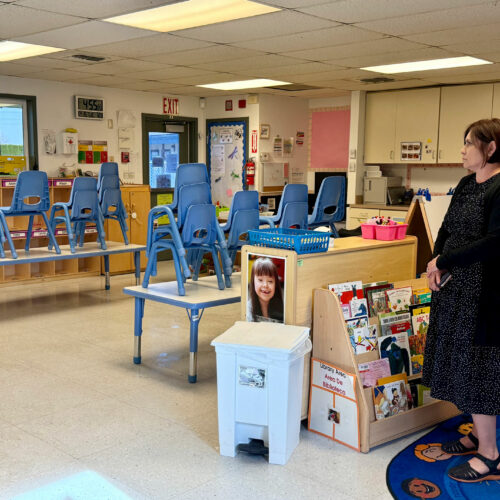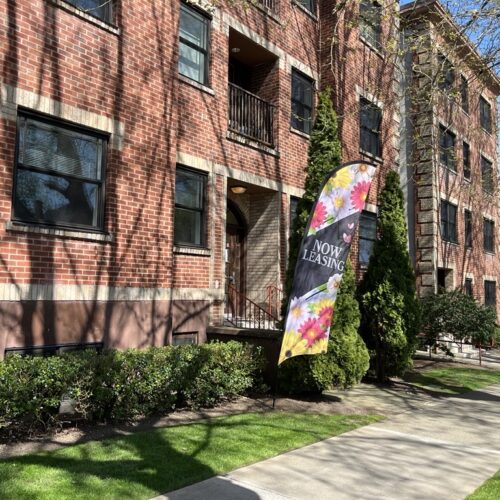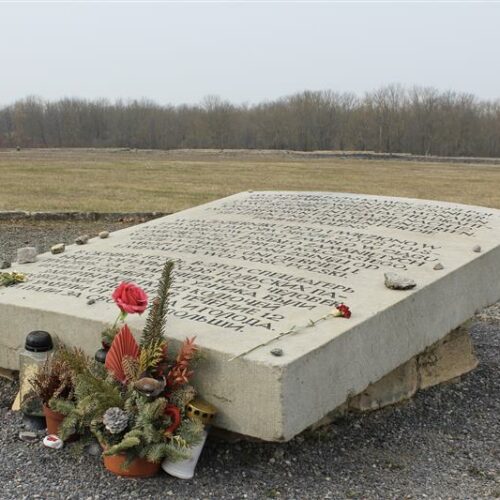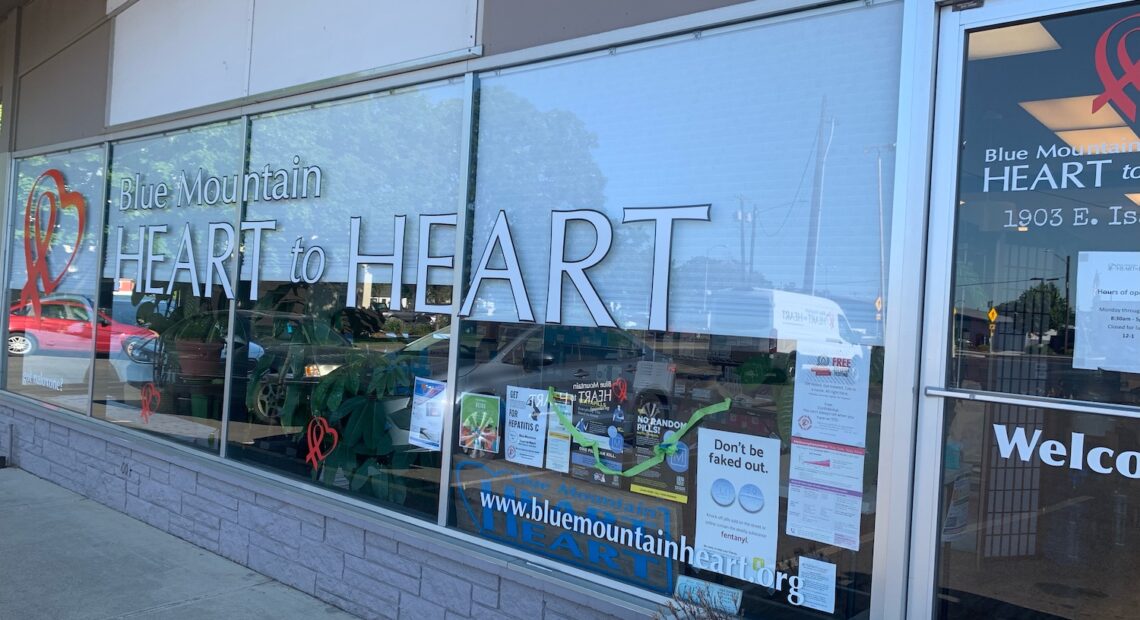
Medication first, and then a whole-health approach
Listen
(Runtime 1:10)
Read
Editor’s note: This article has been updated for clarity regarding funding for the program.
A couple of blocks off U.S. Route 12 in Walla Walla, Blue Mountain Heart to Heart has been treating people with substance use disorder for over a decade. But, for years, the nonprofit was unable to quickly offer a proven treatment for opioid use disorder: medication-assisted treatment.
Staffers would have to arrange for patients to get an assessment with a trained substance use professional elsewhere to start the medication. Getting that assessment, and then, getting started on the medication, buprenorphine, used to take weeks.
People with opioid use disorder often don’t have weeks.
“I’ve absolutely seen people die waiting for their assessment,” said Everett Maroon, executive director of Blue Mountain Heart to Heart.
Maroon started working there 14 years ago. The organization, founded in the early days of the HIV epidemic, was still reeling in the wake of the Great Recession. He helped the organization pivot to treating chronic conditions beyond HIV, including substance use disorder.
At the beginning of Maroon’s tenure, the nation was on the brink of an opioid use disorder crisis.
However, he said he could not get funders on board with low-barrier, medication-assisted treatment for people to get off opioids. The concept goes against the often punitive approach to drug treatment, which kicks patients out of programs for continuing to use substances, or puts them into a treatment plan that isn’t always a good fit.
“It just meant that most people, they just didn’t get treated,” Maroon said.
Then, in 2019, researchers from the University of Washington approached Maroon. They had trialed a program to get people faster access to medication-assisted treatment at a safe syringe exchange site in Seattle, and found that it was working. The researchers wanted to see how a similar project would do in a rural setting.
Maroon signed on and Blue Mountain Heart to Heart became one of six demonstration sites selected from both western and eastern Washington. Researchers studied this care model across the sites for two years and found it worked.
Data from the study shows that across all sites, the patients served by the community-based medications first model had a 68% lower mortality rate in the first year. Lead researcher Dr. Caleb Banta-Green noted that the research findings are presented with a confidence interval of 95% for the range of 6%-89%. That means if the study were to be replicated 100 times, in 95 instances the findings would be in the range of 6%-89%.
Now, clients who walk into the clinic’s doors and want to get off opioids can get this help. Staffers use the clinical opiate withdrawal scale to determine when the individual can begin using the medication. Clinic staff talk patients through using the prescription, call them after their initial dose and check in with them a few days later. Plus, staff are able to provide patients with a host of other services; many are same-day, and require no appointment or payment.
The care model now has state funding behind it to expand to places with treatment gaps across Washington state. Still, the funding isn’t indefinite, and the future of this care model is unclear.
The legislature has earmarked health engagement hub expansion funds as ongoing, meaning grant funding could be renewed in future budget cycles.
The problem
Between January 2023 and January 2024, Washington saw some of the highest increases in the country for opioid overdose-related deaths, according to the Centers for Disease Control. There were 3,421 cases reported in the state in January 2024, up from 2,849 cases reported in January 2023. These numbers are likely higher, due to underreporting.
The most effective way to treat opioid use disorder is through medication-assisted treatment, according to Banta-Green, a research professor at the University of Washington. Banta-Green was the lead researcher on the 2019 study, which found that low-barrier access to medication first, with continued wraparound services, had a great impact on reducing overdose deaths.
“The simple way to think about this is we definitely want to save people’s lives,” Banta-Green said. “But, we then also want to support people in having lives worth living.”
A number of providers shared how access to this treatment can be life-saving.
Other providers have trialed similar low-barrier access to medication-assisted treatment. Dr. Lucinda Grande, a family physician, was one of the founders of the Olympia Bupe Clinic in 2019. That clinic has removed barriers such as scheduled appointments, Grande said, and patients can leave their first visit with buprenorphine in hand.
The clinic was incredibly popular from the start, Grande said, going from three patients a day to 30 to 40 patients daily by the end of its first year.
The part that was missing, Grande said, was getting people additional services after beginning the medication.
“Once somebody stabilized on buprenorphine, that’s like the first step, and now they can start looking at all their other needs,” Grande said.
The solution
After the University of Washington study showed effectiveness in getting people access to the medications, Banta-Green and his colleagues wanted to broaden their efforts.
“Twenty to 30% of the people who have opioid use disorder are being treated with the most effective treatments, which are medications like methadone and buprenorphine,” Banta-Green said. “So, the treatment gap is about 70% to 80%, and that’s what we’re trying to address.”
The demonstration sites had additional services for patients to access, including care navigators for physical and mental health needs. In the first year of the study, less than 1%, 3 out of 664 patients in the intervention group, died, while a little over 2%, 222 out of 9893 in the comparison group, died.
To create a comparison group for participants in the study, Banta-Green explained that researchers used state records data. The data came from the Department of Health prescription monitoring program, medication use and care utilization data from the Health Care Authority and mortality data from the Department of Social and Health Services.
The researchers used data from people who matched research participants based on location, gender and medication treatment history. While the comparison group had relatively low overdose death rates, Banta-Green said the participants in the community-based medications first model still had even lower mortality rates.
“This low-barrier, drop-in approach is the best model that I’ve seen so far to have a chance that anybody who needs this can access it,” Banta-Green said. “It’s our best chance at trying to have some impact on this horrific mortality rate that we’re seeing with illicit fentanyl.”
For Maroon, it’s not just about preventing death; he said it’s about sustaining life.
“I care about those softer outcomes, too,” Maroon said. “Who got their kids back, who got visitation back, who went from 20 [emergency room] visits a month to three?”
The University of Washington research has yet to be peer-reviewed, so the findings are still preliminary. This study did not look at incarceration rates because of the complications of the COVID-19 pandemic and changes to state drug possession laws.
Researchers did track emergency room visits but did not see a difference for the intervention group.
Grande said she would have liked to have implemented mental health, primary care and social services at Olympia Bupe Clinic, and hopes with the health engagement hubs model the state is trying, clinics like the one she helped create could provide more services.
The money
Funding for the demonstration sites in the study came from the Paul G. Allen Family Foundation.
Banta-Green took the results of the research to the Substance Use Recovery Services Advisory Committee, which he sits on, as a recommendation to lawmakers.
In the 2023 legislative session, lawmakers passed amended Senate Bill 5536. It, in part, funded a health engagement hub pilot program for at least two providers across the state. This year, lawmakers appropriated an additional $3 million to the program. That will provide funding for three additional providers in the 2025 fiscal year.
Sen. June Robinson, of Washington’s 38th Legislative District, was one of the bill’s co-sponsors.
“What appealed to me about health engagement hubs is that they’re not just looking at the person’s opioid addiction, but also looking more holistically at what’s going on in their life, and trying to address primary care needs other than their addiction,” Robinson said.
The Washington State Health Care Authority is the state agency overseeing the program.
Standing up services, and then trying to sustain them
Some providers in the program are worried about what will happen when the money runs out.
In Auburn, HealthPoint has a program it calls Whole Care. It opened for patients in the fall of 2022. The program is meant to take care of South King County’s highest risk patients.
Often, those are people with substance use disorder.
The second floor of the clinic is dedicated to the program. It’s designed to be more comfortable than a traditional clinical setting. There are no exam tables in treatment rooms, there is a pharmacy for patients to pick up their buprenorphine products the same day, and providers have more time to spend with patients.
Whole Care follows the model of offering medication for opioid use disorder and, at the same time, connecting patients with other services.
The problem is funding, said Dr. Nate Kittle, associate site medical director for Whole Care and addiction medicine specialty director.
HealthPoint applied for funding through the health engagement hubs project earlier this year and was selected. When the healthcare organization filled out the application, the staff’s understanding was it would offer two years of funding. But they were notified funding would end on June 30, 2025.
“We’re kind of scrambling a little bit to build some of our services,” Kittle said.
Kittle said he believes in the model and thinks it will succeed. However, he said once funding goes away, the program will be at risk.
Traditional medical reimbursement relies on the number of patients seen by a provider. That means that these clinics don’t get reimbursed for all the outreach activities, including engagements by nurses and social workers.
“This model won’t succeed unless there’s payment reform at the state level,” Kittle said.
Banta-Green agreed with the need to fund this care differently, saying that instead of paying for the fee of the services, the bundle of services needs to be paid for. He compared it to how the Ryan White Act allowed for comprehensive HIV care funding nationwide.
Cost-modeling by researchers in Boston showed how these services at syringe exchange programs may be cheaper.
Proving success
The Health Care Authority, along with other agency partners, will be doing research on people’s care utilization and the impacts on morbidity and mortality. The partners are also tracking people showing up in hospital emergency departments.
Kittle said he would like to see emergency department utilization and infectious disease treatment rates tracked, as well, to determine public health outcomes for the project.
The limitations to scaling this up are financing and staffing.
There are also ever-changing problems in substance use disorder, one of those being changing substances.
Fentanyl, now the primary opioid used by people with substance use disorder according to providers, poses its own challenges. Grande said beginning buprenorphine too close to when a patient used fentanyl can cause someone to go into precipitated withdrawal.
“It takes a really long time for the fentanyl to get out of the person’s system,” Grande said, “and sometimes they have to wait three, four, even seven days before they can take buprenorphine without it actually making them sicker instead of better.”
Opioid withdrawal can cause vomiting, diarrhea and, for some, cardiac problems. Left untreated, these can result in death.
There are strategies medical providers are using to help people get off of fentanyl and onto buprenorphine without such an intense withdrawal response. The synthetic therapeutic opioid, methadone, which is more strictly regulated, does not cause precipitated withdrawal, but it too comes with its own risks, Grande said.
Easing access to methadone, while still keeping it under some regulation, could be the next solution to ensuring more people have access to the medication-assisted treatment that can help them live full lives, Grande said.

